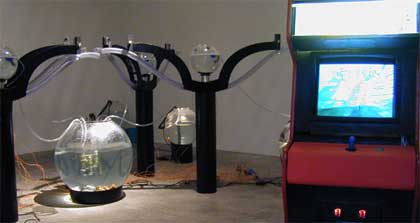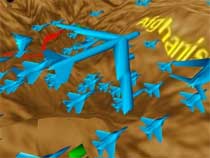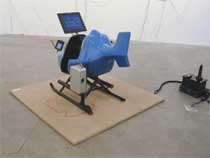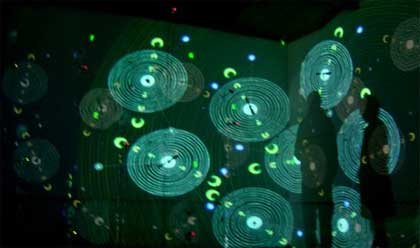 John Klima‘s work is probably one of the most curious, challenging and fascinating i’ve ever read about. He has exhibited all over the world his remote-controlled fiction piece, a bunch of “robugs” that think they are the new Jackson Pollock, a kiddie ride inspired by the conflict in Afghanistan, a pre-Google-Earth installation, his coin-operated arcade game which puts at risk the life of a real golden fish and some maliciously user-unfriendly interfaces.
John Klima‘s work is probably one of the most curious, challenging and fascinating i’ve ever read about. He has exhibited all over the world his remote-controlled fiction piece, a bunch of “robugs” that think they are the new Jackson Pollock, a kiddie ride inspired by the conflict in Afghanistan, a pre-Google-Earth installation, his coin-operated arcade game which puts at risk the life of a real golden fish and some maliciously user-unfriendly interfaces.
Klima is currently a research scientist in the Mathematics department at New York University, and adjunct Professor of Digital Media at the Rhode Island School of Design.
His bio states that: “Consistently connecting the virtual to the real, Klima builds large scale electro-mechanical installations driven by 3d game software he programs from scratch. The virtual computer imagery mirrors and extends the potential and agency of the physical components to produce cohesive worlds that are both humorous and sinister.” Well, as you’ll read in this interview, if one had to choose between “sinister” and “humorous” to define Klima, the latter adjective would by far be the most appropriate.
What’s your background?
When I was a kid, I always messed around with electronics and computers. I built lots of kits, and I had a TRS-80 model II, with 4k ram, we eventually upgraded to a whopping 16k. The TRS-80 was essentially the very first PC. Back then (1978?), I taught myself programming in BASIC. At that time, bootlegging software essentially consisted of typing in the code from a book or a magazine, or doing an audio tape-to-tape copy. Those were the days. I wrote a bunch of games in BASIC, the most complex being a rodent control simulation in an urban setting I wrote as project for my biology class. The teacher refused to believe I did the thing myself and accused me of plagarism. Asshole. It’s funny how to this day most of the criticism of my work in the mainstream press has come from a similar position, lacking a fundamental comprehension of the systems involved. Anyway, I was just starting to “poke” around in machine language (pun intended), but after being a proto-techno-geek for many youthful years, I eventually became interested in girls and punk rock, so I went to art school. I have a BFA from SUNY Purchase, the NY state system’s art school, 1987. I loved it – I got to draw naked girls for 3 hours a day, and I was exposed to great professors who were prominent in their fields. It was cheap, two grand a year. No student loans, no debt, excellent value for my educational dollar. I primarily studied photography under Jan Groover, my “art mother,” but I did a lot of sculpture and drawing too. I never really painted much until I was 30. At the time I was consulting as a computer programmer, making a bunch of money, and making a little software art on the side, not thinking anyone would be interested in such a thing. I took a painting class at the 92nd Street Y here in New York, and I rememebered what the hell the purpose of my life was. It was great fun, painting flowers and vases with little old ladies on the upper east side, and there I was using big fat brushes and bright colors, and bending the space in all manner of ways.
When I was working with photography, I was exclusively interested in still-life, but I was always having trouble finding the right object to resolve the composition and content of my image. I realized with the computer, and with 3d technology, I could just make the object exactly as I needed it. I really feel there is a direct link to the work I was doing when I was 20, in traditional (if you call photography traditional) media, and the work I do now.
Anyway, I more or less suck at math, or at least the public school system thought I sucked at math, so I was not tracked into the advanced science and math courses in high school. This really bothered me – it was my first experience of being told I was not capable of something. It is with great irony that my current professional title is “Research Scientist in the Courant Institute of Mathematics, New York University.” Funny how all you need is a BFA (hell you don’t even need that) and a major institution will label you a scientist (for your euro-readers: BFA = bachelor’s degree, fine art). I am currently essentially a drop-out from the MS program at Brooklyn Polytechnic. I completed two semesters last year but I had too many other things to do, and never managed to register for the final semester of my degree program. Maybe this fall I will finally complete the degree, but damn if it does not seem essentially pointless. I teach there now too, which is a particularly funny situation considering I am a dropout. No, no, I will get that stinking piece of paper eventually.
While many interaction/new media artist stress that their work can beintuitively understood, some of your works (Train in particular) require some learning to be fully enjoyed. Why is this learning element important?
Great question. I never claim that my work is intuitive, ever. Quite the contrary. I ask that the viewer come to terms with the interaction. I don’t really believe in the notion of intuition in terms of a user interface. There is no such thing as intuition, only habit. A scroll bar is intuitive only if one has seen a scroll bar before. If one has never seen a scroll bar, good luck. If a user is indeed familiar with a scroll bar and if this scroll bar suddenly looks or behaves differently than every other scroll bar, you’re really in trouble. Yes there are visual cues that may help with understanding how an interface device functions, but no device is intuitive if one is coming from a place of inexperience. Each individual is different, and behaves differently with an interaction. You can never address the needs of all users in an interface, and as an artist, I choose to address none. When I showed “EARTH” at the Whitney, there was a visitor who was furious at me because it was not a point and click interaction. Somehow I was obligated to make my interface just like a website, where you point and click. This person was literally furious, venomous, angry at me because my artwork did not accomodate her habits. It was hilarious really.
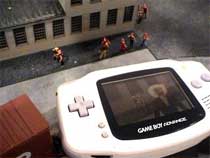
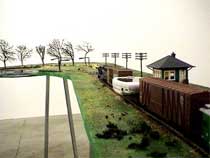
“Train” was a particularly challenging proposition because I thought I was making something that was very easy to use, but viewer expectations and assumptions resulted in an outcome completely unexpected. As I mention at length in my essay for a-minima, many users assumed their cell phones, the input device for the piece, were to function as does a remote control for a television. They pointed their phones at the trains and started pressing buttons, where what they needed to do was listen to the audio on the phone. Also, many assumed that they were controlling the trains, where what they were actually controlling was the track the trains ran on. They expected to see an immediate reaction through their manipulations, where in “Train,” the results of the viewer’s actions can sometimes manifest several minutes after the input. There is a general expectation by viewers of new media and interactive works that they will immediately see themselves in the work, that the system is essentially a mirror. My work only rarely operates this way, and when it does, it is only a small aspect of the piece, not the central theme. In the very rare case it does become a central theme, the nature of that desire to be mirrored *is* the theme.
I ask the viewer to come to terms with the interaction in my work, and not vice versa. It is not designed to be easy for the viewer to use. The process of learning the system, or in a sense, accepting the system and flowing with it, is a critical aspect to the work. The systems I create are complex and layered. I do not always have a plan ahead of time how the system will function. The work often consists of several parallel processes that run independently of each other, communicating with each other to produce a final outcome. This is what is interesting to me, and I go through my own process of discovery with my own work. I need to learn how to use my own systems. I love this, because this way I get to enjoy the work as a spectator and not only as the creator.
«EARTH» is a geo-spatial visualization system that retrieves real-time data from the net and positions it onto a 3D model of the Earth. What was the impetus for this work?
Well, clearly, the impetus for “EARTH” was the novel “Snow Crash” by Neal Stephenson. In his novel he describes an interface that collects all the data in the world and represents it in a geospatial interface. It is a very compelling idea, a beautiful idea, and there have been several implementations of this idea over the years. The most well known at this point in time is of course, Google Earth. I pride myself in the knowledge that I built my earth several years prior to Google, though of course there were several implementations prior to mine. However, there are many aspects that make my implementation unique. All the data has been extracted from publicly available sources. It is all free data. Also, I incorporate visualizations of METAR weather data. This is the primary data source for every weather ticker and website that offers global weather information. METAR is an odd old data spec, a text specification, word of mouth so to speak. I take these observed weather conditions and create a visual record of this linguistic report.
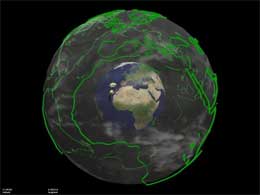
I also make no provision for the viewer to find a specific location. This is not the point. In “EARTH” you can not type in “San Francisco” and instantly zoom up to the Mission district. There are no political boundaries, no roads, no icons indicating the location of a Motel 6 or a Starbucks. Everything you see in “EARTH” has been processed through my eye, so to speak. The data is acquired in a raw form that I then re-present in a highly aestheticised manner. I don’t really clean up the data. I don’t blend the seams, I don’t smooth the transitions between data layers, I don’t correct discrepancies between the various coordinate systems each data layer uses to locate itself. I find these discrepancies, these inaccuracies to be very interesting. They point to the flaws in our understanding and ability to quantify the world. When the software tries to stich the seams, blend the layers, and create a false verisimilitude, it is essentially a lie – the representation is no more accurate than mine. In many ways, it is less so, because it endeavors to hide the truth of the inaccuracies and flaws.
Terrain is a ‘dynamic display surface’ that uses only light to allowviewers to “insert” themselves into the data stream. How did theproject evolve from its initial concept to its current form? What werethe challenges of creating such a complex system?
Initially “Terrain” was supposed to be an extension of “EARTH,” allowing the display of the “EARTH” dataset on a dynamic three-dimensional projection surface. So the user would grab a joystick, and be able to fly over Mount Everest or other such place, seeing the terrain form on the surface right there in front of them. The mechanics are simply a display device, and any information can displayed upon it, so I am sure one day I will use it for it’s initially intended purpose, but I had become a bit tired of working with geo-spatial information so I decided to render a female form on the surface instead. There has been a long standing connection in art between the female form and landscape, and of course “mother nature” and all that, so it was a logical choice for subject matter. But there is more to it than that. Terrain uses the projection beam as the means of control and data transfer. There are no wires connecting the computer to the surface. The light focused from the projector on a matrix of light sensors is translated into the matrix of highs and lows forming the surface. The viewer can block the light, cast shadows on the control matrix, and thus directly manipulate the surface. One can quite literally insert oneself into the data-stream. In the press release for it’s debut at Postmasters gallery in New York, I made a comical remark about it being as close to Keanu Reaves stopping a bullet in the film. A critic for Art Forum who evidently had no sense of humor, took me quite literally and trashed me in his review, calling me pretentious or something to that effect. But that is another rant.
The rant that I was currently following is about the means of control. There are countless new media works, some of them very good, others simply derivative, that use video tracking systems to allow a viewer to be inserted into a picture, to manipulate an image in real-time, and what have you. Camille Utterback‘s “Text Rainâ€? is an example of a very good video tracking piece. Still though, to me, these pieces are vaguely pornographic in that they pander to the audience’s need for instant gratification, they ask very little of the viewer in terms of their interaction, they are transparent interfaces. They are always very popular at festivals and in museums because they are immediately understood, and the viewer gets to see themselves in a mirror. Because Terrain has a similar interaction system, though no camera is used, I decided to employ imagery of a Danish porn star working in the 1970’s named Tiny Tove. Sexy little thing she was. I have to wonder what became of her. I liked this idea very much, it is hidden in the piece, but once you know it is there, it is quite evident. I also feel that few new media artists are addressing sexuality, or sensuality, in a manner that was not strictly from an academically critical perspective. In general, I think we are a bit too serious, too scientific, so using Tiny Tove as my subject seemed a perfect solution to my boredom with geo-spatial data. The nature of the surface is very skin-like. I first used latex as the material, but it felt a bit too S&M, a bit too creepy, so I switched to spandex. The nature of the control also lent itself to using Tiny Tove, because you can manipulate the surface, you can touch it, but only remotely, only through the image can you have contact with this object of desire.
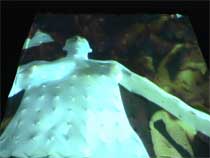
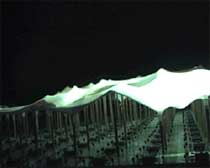
The process of developing the technology for Terrain was a long one. In short, the goal was to develop a matrix of actuation and control for less than $10 per point. Terrain in it’s complete installation has 450 points, and it came in at about $12.50 per point in materials. The means to develop such a complex system is of course, to make it simple. All decisions were based on minimizing cost and complexity, and you could not have a better guiding principle. The system is essentially an analog system, made from components that have existed for 50 years. The only thing that makes it “digital” is that it is arranged in grid. Each point is completely independent, controlled by it’s own independent light sensor, in the most direct manner possible. Initially I expected to use something like DMX-512 or MIDI to control the actuators from a computer. But in the end, the light projection mechanism was the simplest and cheapest approach, and proved to be the most elegant, and advantageous in that it exposed the data-stream to direct manipulation by the viewer.
When I began work on “Terrain,” I had no idea at all how it would actually function. I invented a circuit from scratch that basically came to me in dream, literally. I woke up one morning thinking “Hey couldn’t I just connect a motorized slide-pot to a window comparator driving a motor H-bridge?” It turns out that indeed one can do just that. The circuit, with the light sensors, completes an electrical loop. It’s really quite elegant – the actuators are constantly going up and down a tiny amount. As it moves up, the resistance in the slide pot is compared to the resistance through the light sensor and the H-bridge turns the slide-pot’s motor the opposite direction, until the resistance equalizes. If the light changes, the motors move to equalize the resistances. I get a thrill every time I think about how simple and elegant it is.
The Museum of Contemporary Art in Badajoz (Spain) has taken on the care and maintenance of Train. How heavy is the care and maintenance of suchinstallation? How frequent is it for a new media artist to have one of his/her works taken care of by an institution or organization?
Ha! Well, it is a giant model railroad controlled by cellphone, so you tell me! Seriously though, sure it’s a pain, when the thing is running. When it is in storage (the natural state for 99.99% of all the art in the world) it’s no more difficult than any other large fragile work of art. Train consists of a single branching and looping track, with two separate trains running on it. There is a complex system in place to keep the two trains from colliding. This system is a failsafe system, It works 100%, unless of course a wire breaks, or an electrical connection fails. It is an extremely robust, analog, system and has run flawlessly for six months. The major problem turned out to be the computer that runs the phone interface. It’s hard-drive failed. I bought a brand new machine for the piece, and the drive failed in less than six months. hey, shit happens. Also, occasionally a train jumps the track. It happens in the real world too. But I think this is funny, as it gives the guards in the museum something to do. They get to play with the piece. The hardest thing however is getting them to understand that it is OK to play with the piece. You are not supposed to touch Art, but in the case of train, you have to touch it occasionally.
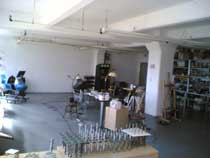
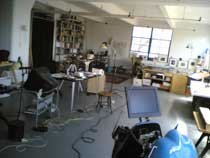 John Klima’s studio
John Klima’s studio
Which role should art institutions and galleries play in regards to work like yours?
Well, same role as they always have, present and preserve. In the case of work like mine, there will always be certain issues that they are completely unfamiliar with. But in time, institutions will have qualified individuals available who can resolve these issues as would any traditional art conservator or art handler. At this point, nobody seems to know who’s job it is when a machine needs a re-booting. Can the guards do it? Is it the job of the art handlers? The A-V people? The IT department? In a unionized institution like the Whitney Museum, this becomes a real issue. There are labor laws that could potentially be broken. It’s somehow ridiculous, but at the same time, necessary.
Do you think it is possible for new media artists to support themselves financially? Which factors could improve the situation?
Of course it is possible, many of us do it. One can have teaching positions, and one can chase after grants, supplement this with gallery sales, commissions, etc, and cobble together a livelihood. In some cases one can have a very acceptable income, but not without certain compromises. At this point, I think it is completely impossible for a new media artist to make what ever work they feel like making, hang it on a wall, and expect to make a living. For me, the essential problem is that festivals, grants, commissions, etc all seem to have a theme that needs to be addressed. Lately, mobile devices and social networks seem to be the hot topic. So what do you do if you have no interest in the “theme de jour?” You end up shoehorning what you want to do, to fit within the current theme, and the work suffers because of it. Lately, I am not so interested in chasing grants, participating in festivals or finding commissions. I am also not so interested in teaching, though I do teach a class or two here and there.
Fortunately for me at this moment, a system I recently invented for my own work, has been shown to have commercial viability in the computer game industry. I am not really at liberty to discuss it further, it’s kind of top-secret. Suffice to say, it is a procedural animation and AI system for generative character behavior and motion. Anyway, I hired a former student of mine from Brooklyn Polytechnic University and with my guidance, he is implementing the technology for a company out in San Francisco. He’s thrilled to be working on something far more interesting than a Visual Basic front end to a SQL Database, and I pay him very well. Thus, he works really hard and thus I can explore my technologies and artistic practice free from the contstaints of the theme de jour, free from the requirements of a commissioning body, and free from the limitations on content that any publicly funded art practice forces on the artists it supports.
The point is however, that as new media artists, we have skills that are useful to the world at large. The goal for us I think, is to insure that the work we must do outside of our artwork, does not interfere with our ability to make art. In my case, I am fortunate in that a number of things came together to allow me to hire someone to help me do the commercial work, and the commercial work is exactly what I am developing for my own artistic uses. If all goes according to plan, it will require very little of my time to perpetuate itself, and the work I am doing for this company is precisely the work that I would be doing for myself anyway. I was very careful to stipulate in the contract that I am free to use the technology I develop for my own purposes, as long as those purposes are not in direct competition with them. Well, as an artist who shows in galleries and museums, I think it very unlikely that this in any way competes with game industry.
A constant element of your work is game. Are you a gamer yourself? Which games do you like to play?
Oh yes, I am an avid gamer, unfortunately in retirement. I don’t have the time to play much any more, so I am essentially a binge player. When a truly new game is released, I get it immediately and play it non-stop, sometimes for 48 hours at a stretch without sleep, sometimes for several weeks. I did this with “The Sims” when it first came out. I did this with “Neverwinter Nights,” “Dungeon Siege,” and “Freedom Force” as well. I love “Freedom Force,” it’s a hilarious comic book superhero game that takes place in “a completely destructable world” as is printed on the box cover. I turned on Mark Napier and his kids to this game and they love it too.
I am not so fond of first person shooters, I just don’t have the rapid hand-eye coordination. I like third person role playing games and simulations. I like real-time strategy games too, like the “Total War” series, but I try to avoid them because they really chew up your time. I like games where you need to think and plan. I tend towards games that are not based on reality, with the exception of the real-time strategy games.
The one game I lost most of my life to, was “Ultima Online,” essentially the first massively multi-user persistent on-line role playing game. I played this game 80 hours a week, I worked a single character to the highest possible level, a Grandmaster Mage. I could have sold her for real money, but when i quit the game, I deleted her. It was hard to do, but I just couldn’t stomach the idea of some silly rich kid running around the world as me. Oh and I always, always, always, play a female character. I won’t play a game that does not allow me to play as a woman. The whole point for me is to be something I am not, and this first choice when selecting a character in a new game is indeed an essential one for me. If you consider the third person perspective, this is not such a surprise – in many ways I simply prefer to look at a cute little scantily clad elfin ass than some buffed-up meat-head steroid-overdosed slugger. I tend to play spell-casters that hang in the back of the tactical group, managing the combat and providing crucial assistance where needed.
I also get together with a group of guys weekly to play traditional “paper and pencil” strategy board games. These are games sort of like “Risk” but far more complex. A consistant favorite when we can amass six players for two consecutive weeks is “History of the World.” More often lately we have four or five players, in which case we play “Louis XIV”, “Puerto Rico” or “El Grande.” These are all games that are based on some historical context, with a complex resource management and player exchange system. Some guys get together for poker night, or to watch a football game. What can I say, once a geek, always a geek.
What are you working on now? I read about domdams and about another project, this time in collaboration with France Cadet. Can you tell us something about them?
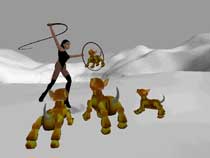 Yes the Domdams are a new project I am very excited about. I am taking plastic Gundam model kits, all of which are male characters, and “bashing” the kits, giving them sex change operations, to create a universe of female Gundam characters. I am making them ultra-sexy, equipped with various bondage and dominatrix accouterments, thus the name Domdam. The models will be placed in a variety of diorama scenes that convey a narrative, essentially the story of Rebecca, a female Gundam struggling to survive in a male dominated mecha-universe.
Yes the Domdams are a new project I am very excited about. I am taking plastic Gundam model kits, all of which are male characters, and “bashing” the kits, giving them sex change operations, to create a universe of female Gundam characters. I am making them ultra-sexy, equipped with various bondage and dominatrix accouterments, thus the name Domdam. The models will be placed in a variety of diorama scenes that convey a narrative, essentially the story of Rebecca, a female Gundam struggling to survive in a male dominated mecha-universe.
I had no idea how much fun it would be to perform these operations, I love the physical activity. I have always worked with my hands, and it is a welcomed break from the computer. The series will of course have a digital game-like component as well. Each physical scene will have a virtual equivalent where the narrative is expanded. The physical scenes will essentially be equivalent to the frames of a graphic novel, and the virtual scenes will animate the graphic novel frames in a procedural manner. This is the technology my assistant and I are implementing for the game company in San Francisco, and will become the core of my work far into the future.
I have also begun working with France Cadet on a project. She has a wonderful series of work based on a relatively inexpensive robot dog, sort of a knock-off of Sony’s Aibo, called the I-cybie. She re-programs and re-works the appearance of these dogs so they behave in a variety of humorous, disturbing, and sexy ways. Rather than me explaining the nature of the her work, best thing is to see it online, www.doglab.net. She has also been working with a brilliant engineer, Jean-Pierre Mandon, who has developed a small WiFi device called PicoIP, small enough to add to the electronics of the I-cybie, enabling wireless control of the dogs, from a separate computer. So again, I will employ this top-secret technology I have been developing to create a virtual dog circus act, with a virtual France Cadet as the ringmaster, and with a parallel manifestation in the real world, through the PicoIP, to France’s robot dogs. Like you, she got a kick out of the fish piece and suggested we do something similar. It is very interesting working with her because she is not really interested in the game aspects that have driven my work thus far, so essentially we are not approaching the interaction in the piece from my usual game driven perspective. I like this, as it forces me to think in a manner I am not accustomed to, and in a manner that in many ways I have always rejected in favor of the game approach.
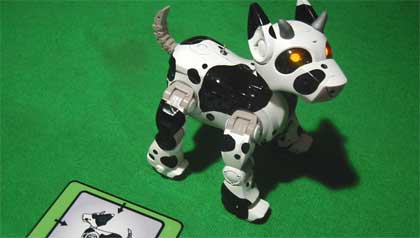 Dog [Lab] by France Cadet
Dog [Lab] by France Cadet
Any artist(s) or researcher(s) you find particularly inspiring? Why?
Well, of course I am a big fan of France Cadet. I suppose, she has become my muse. I never really believed in the notion of a muse, having never had one, I thought it a rather old-fashioned notion. But like so many things in life, you don’t know a thing about it until you experience it. It is not really that she has changed the way I think about things, or “inspired” me to create work, it is more like she gave me a reason to make the work in the first place. She became the prototype subject that kept my interest long enough to take the idea I had for this top-secret technology, and sit down and spend the time it took to actually build it. She also has allowed me to explore themes I have always wanted to explore, but never allowed myself to explore, for a variety of reasons. I am extremely pleased with what I have been doing since meeting her and spending time with her. I feel in many ways that I am finally doing what I want to do, in complete artistic freedom, without having to shoehorn my ideas to fit into a fashion or an artistic theme I have little or no interest in. It is really quite odd actually, and a bit scary too, that meeting one person can so dramatically steer the course of my artistic practice. It was totally unexpected, and when it occurred, I had to pursue it fully, and not without great cost in other aspects of my life. However, those costs have been fortunately offset by the opportunities that this new artistic path, lying dormant for some 20 years, have opened up.
Thanks John!

